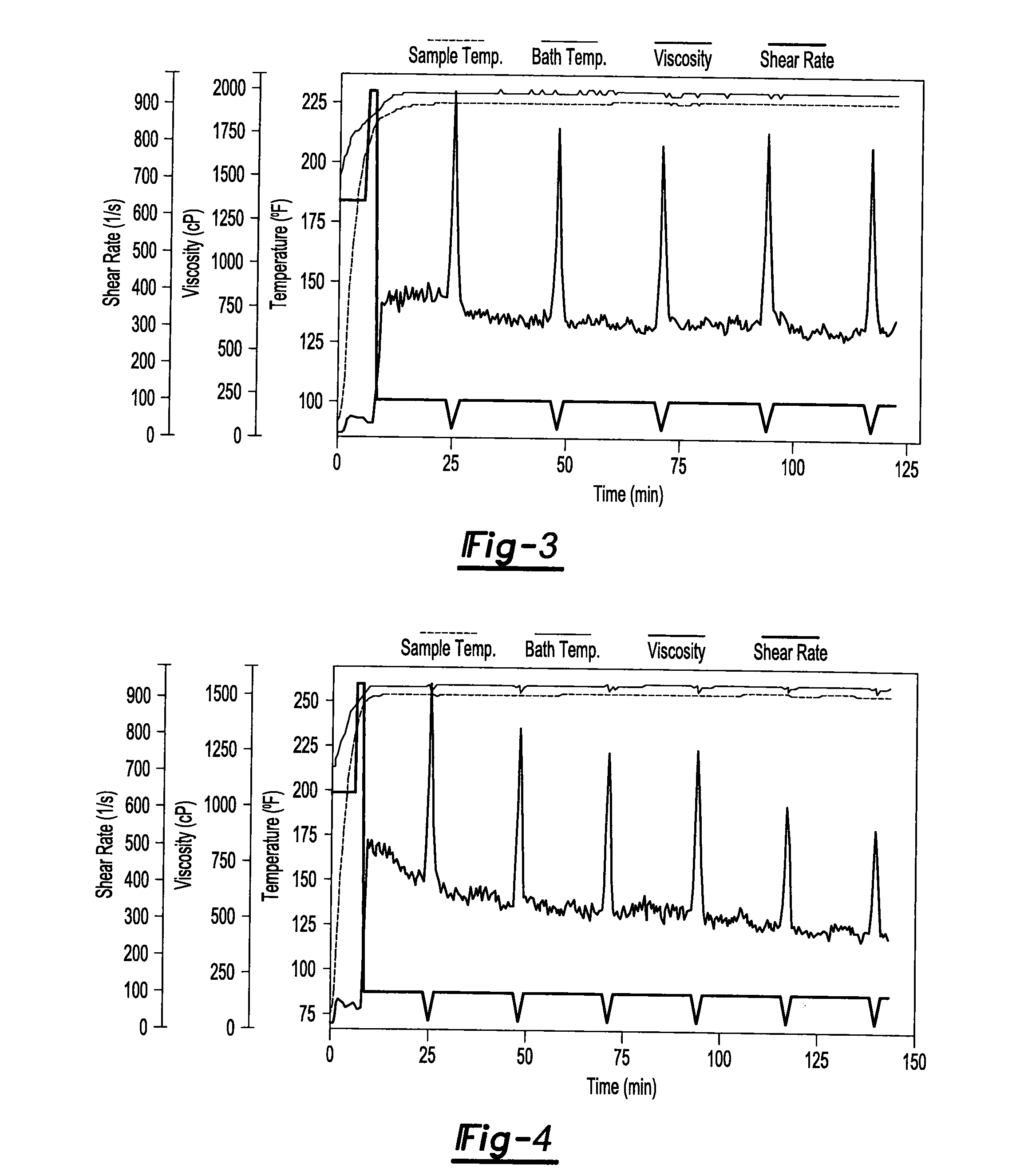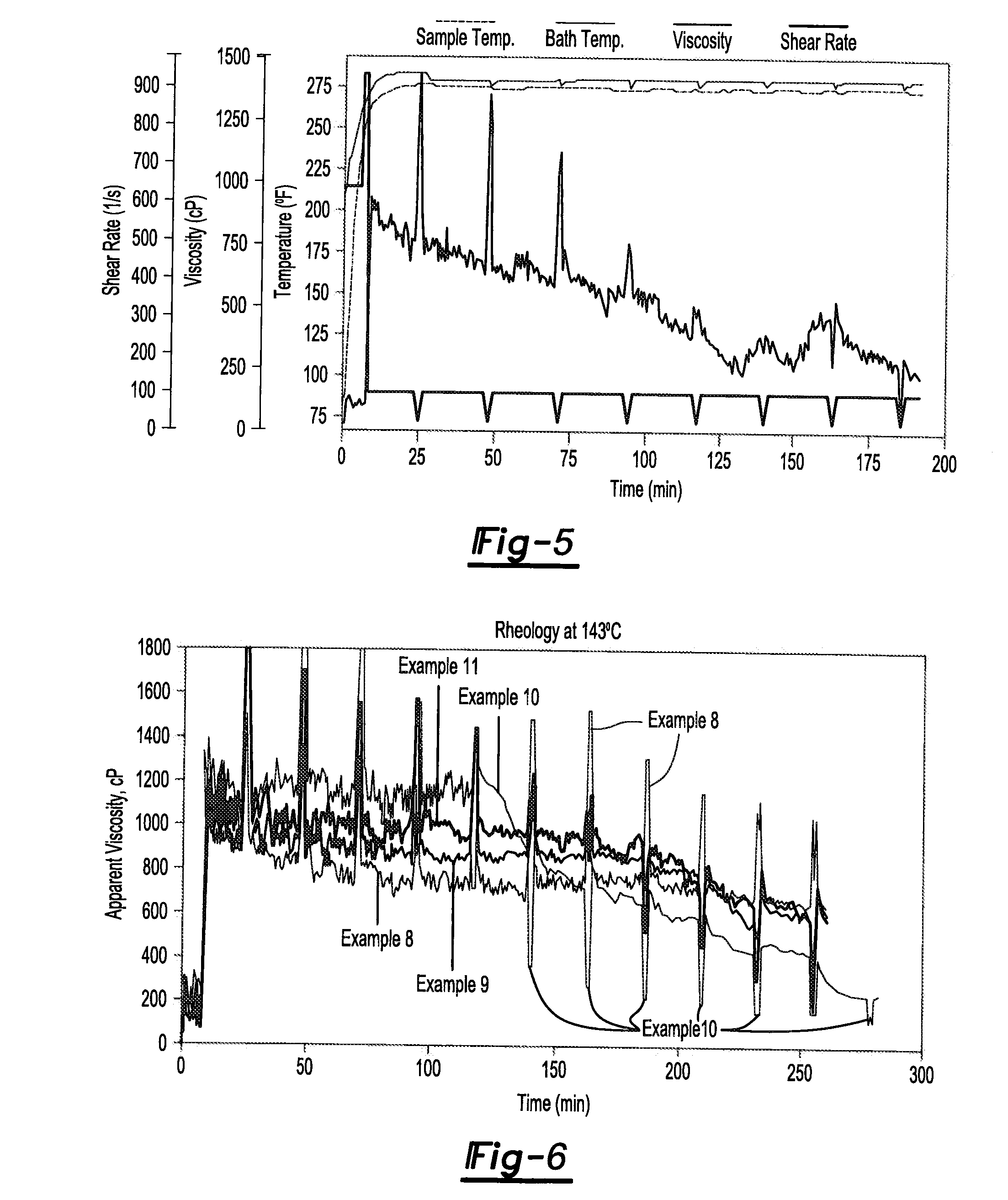[0006]One or more of the above needs may be met with an additives package for use in a fracturing fluid composition (e.g., for fracturing subterranean structures to increase the yield of petroleum and/or hydrocarbon gases from the structures) comprising one or more gelling agents; one or more cross-linking agent; and one or more high temperature stabilizers; wherein the additives package further comprise an ingredient selected from the group consisting of a clay stabilizer, a metallic base, a cross-link retarder, a gel breaker, and any combination thereof; and wherein the additives package optionally includes a diluent; so that the additives package may be used in a fluid composition for fracturing a subterranean formation.
[0007]The additives package may be further characterized by one or any combination of the following features. The cross-linking agent may include a boron containing compound. The high temperature stabilizer may include a thiosulfate, an amine compound, or both. Any clay stabilizer may include a metal halide salt. Any cross-link retarder may include a gluconate salt. Any gel breaker may include a metal bromate. Any diluent may include an alcohol. The additives package may include a metal halide salt, a metallic base, a gluconate salt and a metal bromate. Any metal halide salt may include potassium chloride. The gelling agent may include a guar compound (e.g., hydroxypropyl guar). Any metallic base may include a metal hydroxide. Any metallic base may include an alkali metal hydroxide, an alkaline earth metal hydroxide, or any combination thereof. Any metallic base may include sodium hydroxide. Any gluconate salt may include sodium gluconate. Any thiosulfate compound may includes sodium thiosulfate. The boron containing compound may be a boron salt. The high temperature stabilizer (e.g., the amine compound) may include one or more alkanolamines. Any alkanolamine may be a monoalkanolamine, a dialkanolamine, a trialkanolamine, or any combination thereof. Any alkanolamine may include a trialkanolamine. Any alkanolamine may include an ethanolamine, a n-propanolamine, an isopropanolamine, or any combination thereof. Any alkanolamine may be a triethanolamine. The additives package may includes the alcohol. Any alcohol may include a diol selected from the group consisting of ethylene glycol, propylene glycol, a derivative thereof, and any combination thereof. Any alcohol may include an alcohol containing from about 1 to about 20 carbon atoms (e.g., 1-10 carbon atoms). Any alcohol may include methanol, ethanol, n-propanol, 2-propanol, n-butanol, 2-butanol, isopropanol, or any combination thereof. Any clay stabilizer (e.g., any metal halide salt) may be present at a concentration greater than about 5 wt. %, or even greater than about 30 wt. %, based on the total weight of the additives package. Any clay stabilizer (e.g., any metal halide salt) may be present at a concentration less than about 95 wt. %, or even less than about 70 wt. % (e.g., from about 40 wt. % to about 60 wt. %), based on the total weight of the additives package. The gelling agent may include one or more ingredients and may be present at a concentration greater than about 1 wt. %, or even greater than about 5 wt. %, based on the total weight of the additives package. The gelling agent may be present at a concentration of about 35 wt. % or less. The gelling agent may be present at a concentration of about 20 wt. % or less. The gelling agent may be present at a concentration from about 10 wt. % to about 15 wt. %, based on the total weight of the additives package. Any metallic base may be present at a concentration greater than about 0.1 wt. %. Any metallic base may be present at a concentration greater than about 1 wt. % based on the total weight of the additives package. Any metallic base may be present at a concentration less than about 12 wt. %, or even less than about 8 wt. % (e.g., from about 1.5 wt. % to about 3.5 wt. %), based on the total weight of the additives package. Any cross-link retarder (e.g., any gluconate salt) may be present at a concentration greater than about 1 wt. %, or even greater than about 4 wt. %, based on the total weight of the additives package. Any cross-link retarder (e.g., the gluconate salt) may be present at a concentration less than about 25 wt. %, or even less than about 15 wt. % based on the total weight of the additives package. Any cross-link retarder (e.g., the gluconate salt) may be present at from about 7 wt. % to about 11 wt. %, based on the total weight of the additives package. The high temperature stabilizer (e.g., the thiosulfate compound) may be present at a concentration greater than about 2 wt. %, or even greater than about 5 wt. %, based on the total weight of the additives package. The high temperature stabilizer (e.g., the thiosulfate compound) may be present at a concentration less than about 35 wt. %, or even less than about 20 wt. % (e.g., from about 10 wt. % to about 15 wt. %), based on the total weight of the additives package. The cross-linking agent (e.g., the boron containing compound) may be present at a concentration greater than about 2 wt. %, or even greater than about 5 wt. % based on the total weight of the additives package. The cross-linking agent (e.g., the boron containing compound) may be present at a concentration less than about 35 wt. %, or even less than about 20 wt. % (e.g., from about 10 wt. % to about 15 wt. %), based on the total weight of the additives package. The high temperature stabilizer (e.g., the amine compound) may be present at a concentration greater than about 0.5 wt. %, or even greater than about 2 wt. %) based on the total weight of the additives package. The high temperature stabilizer (e.g., the amine compound) may be present at a concentration less than about 35 wt. %, or even less than about 20 wt. % (e.g., from about 5 wt. % to about 15 wt. %), based on the total weight of the additives package. Any diluent (e.g., any alcohol) may be present at a concentration greater than about 0.5 wt. % based on the total weight of the additives package. The alcohol may be present at a concentration less than about 50 wt. % based on the total weight of the additives package. The additives package may be free of zirconium. The additives package may be free of titanium.
[0008]Another aspect of the invention is directed at a fluid composition for fracturing a subterranean formation including an additives package, such as one described herein. This aspect of the invention may be further characterized by one or any combination of the following. The fluid composition may further comprise about 50 wt. % or more of a carrier liq
 Login to View More
Login to View More 


